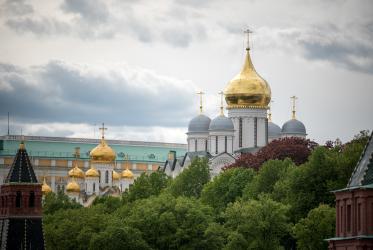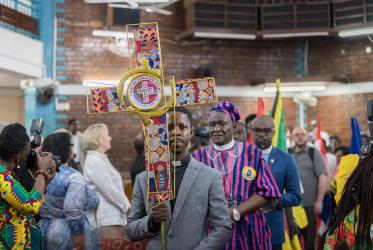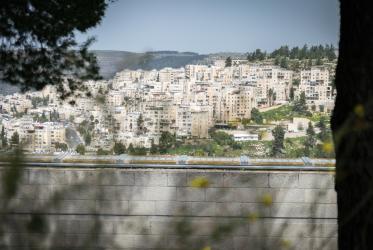Your Holiness, Eminences, your Excellences, sisters and brothers in Christ, dear friends,
We are gathered today in this holy place, Holy Etchmiadzin, in the land that was proclaimed as the First Christian state in the history of humanity. However, we are gathered in the context of yet another tragedy in the life of the people of this land, the Armenian people.
What better example than Holy Etchmiadzin can we find today in order to highlight the essential role of Holy Places in shaping and preserving our human identities? Holy places, the living history of our cultural and religious heritage, are the sanctuaries of our faith. The Armenian people, through the history, have paid a very heavy price for the preservation of their Christian faith. That history is written today in the thousands of their churches and sanctuaries. Borders can change, powers and authorities can change, but what remains is the identity of the holy places, witnessing the winds of change.
Today, in Artsakh (Karapagh), as a consequence of the recent tragic conflict between Armenians and Azeris, we witness again a new map, new borders, new frontlines. However, this should not affect the right of the people to remain and practice their faith accessing their holy places.
When one member of our ecumenical fellowship suffers, all members of our fellowship suffer with that member, and their intercessions and expressions of solidarity, of support towards the suffering member make manifest their growth in fellowship. A visible expression of the care expressed by the fellowship of the World Council of Churches to the Armenian people can be seen in the way the WCC has communicated the trials of the Armenian people during the most recent conflict in Artsakh.
On 29 September 2020 the WCC voiced its grave concern over the escalation of the conflict. On 12 October, it called for the immediate end to the military actions and issued a statement on the violations of the humanitarian ceasefire.
One month later, during the meeting of its Executive Committee, the WCC stated that the Armenian communities were “threatened by the renewal of the genocide against their people” and on the same day it issued a new call for “lasting peace founded on justice and human rights”.
Last November, I wrote, on behalf of the WCC, to the director-general of the UNESCO, urging UNESCO to protect religious sites and cultural monuments under attack in Artsakh.
It is in this spirit of mutual care and solidarity nurtured by our common allegiance to God’s gift of fellowship in Christ through the Holy Spirit that my colleagues and I are joining you in this conference.
The commitment to freedom of religion or belief as a fundamental human right, and its close connection to promoting and ensuring peace among nations and communities, is part of the ecumenical movement’s DNA.
The Commission of the Churches on International Affairs (CCIA) – formed in 1946 in anticipation of the World Council of Churches’ own establishment in 1948 – played a direct and vital role on behalf of the ecumenical movement in the drafting of the language of Article 18 of the Universal Declaration of Human Rights (UDHR). Article 18 states that:
Everyone has the right to freedom of thought, conscience and religion; this right includes freedom to change his religion or belief, and freedom, either alone or in community with others and in public or private, to manifest his religion or belief in teaching, practice, worship and observance.
The World Council of Churches, in which CCIA was integrated in 1948, continues to affirm and promote this inclusive understanding of religious freedom, and to advocate for the rights of those denied this fundamental freedom.
WCC engages in the promotion of freedom of religion especially through its work with the UN human rights mechanisms, which are based near the WCC offices in Geneva. In particular, WCC supports the work of the UN Special Rapporteur on Freedom of Religion or Belief through providing him with information about situations of concern around the world, as well as information about good practices to promote the protection of religious freedom or belief.
When member churches and partners are experiencing challenges with regard to religious freedom in their own countries, WCC is also able to share information about these challenges through other relevant UN human rights accountability mechanisms. In 2018, we produced a guide for churches to the principle of freedom of religion and belief, based on biblical insights.[1]
While the protection of holy sites is not explicit in the original formulation of the right to freedom of religion and belief in Article 18 of the UDHR, it is strongly implicit - and essential to the realization of this right in practice. Indeed, it is fundamental to the very identity of people and communities of faith. Holy sites and places of worship are not merely architectural structures or physical locations. They are representative of people’s deepest identities. Precisely for this reason, in situations of conflict they are often deliberately targeted in order to inflict maximum collective trauma on a particular community.
We cannot differentiate between the physical structures of holy places and places of worship, and the people who congregate and worship there, because that is where they find their communal identity.
Likewise, by protecting the physical spaces used for worship, we protect their worshippers. As Sharon Rosen of the international NGO ‘Search for Common Ground’, has observed, by caring for the physical integrity of buildings, graveyards, sacred groves, and other holy sites, we uphold the human dignity of those who hold them dear. And when all segments of society, including governments and people of other faiths or no faith, collectively protect the holy sites of communities, an alternative and powerfully positive message of healing and togetherness is broadcast.
The significance of religious heritage sites for people and communities, for the practical realization of freedom of religion and belief, and for promoting and protecting peace is increasingly recognized. Considerable work has been done to lift up this concern, to provide recommendations, and to promote action.
A particularly significant initiative is that taken by ‘Search for Common Ground’, in partnership with others, which led to the development of the ‘Universal Code of Conduct on Holy Sites’. The Universal Code maps out a practical code of conduct and policy for sacred places worldwide, aiming to improve the protection of holy sites and to promote inter-religious reconciliation. The Code lays out some important principles of high relevance to our discussions here. For example, it stipulates that
Holy sites shall be preserved for present and future generations, with dignity, integrity and respect for their name and identity. They shall be preserved both as sites of religious significance, and as historical, cultural and ecological legacies of their communities and of humankind. They shall not be desecrated or damaged, nor shall religious communities be forcibly deprived of their holy sites.
It also recommends that in public pronouncements and educational activities,
all parties shall promote the preservation of holy sites, acknowledge the significance of holy sites of others as places of worship and sites of identity, respect the sensitivities of others with regard to these sites, and stress their spiritual value rather than any strategic, territorial or military significance. The attachment of a group to its holy site shall not be denied.
Subsequently, at the request of the UN Secretary-General, the UN Alliance of Civilizations (UNAOC) published a ‘Plan of Action to Safeguard Religious Sites: In Unity and Solidarity for Safe and Peaceful Worship’.[2]
The UNAOC Plan is meant to provide a result-oriented framework for action with suggested recommendations to support relevant stakeholders in their efforts to prevent possible attacks against religious sites and enhance preparedness and response to safeguard religious sites and worshippers. The first section explores preventive actions by relevant stakeholders to address drivers that can result in violent acts against religious sites and worshippers, and the second section focuses on actions and recommendations to enhance preparedness and responses to possible attacks by all relevant actors.
Among other recommendations directed to Governments, the Plan proposes the continued development of strategies and tools aiming at strengthening the protection of heritage, including that of religious interest, and preventing the instrumentalization of culture from exacerbating religious differences and tensions.
And among the recommendations to religious leaders, the Plan encourages proactive and regular engagement in interfaith dialogue, including the promotion of solidarity and resilience; and vocal and active solidarity when religious sites and worshippers from other religions and faiths are targeted.
Of course, within the UN system, UNESCO has long held responsibility for administering the World Heritage Convention of 1972, which links together in a single document the concepts of the conservation of nature and the preservation of cultural properties. Within this framework, UNESCO is mandated to play an important role in protecting and promoting cultural and religious pluralism, particularly by safeguarding cultural and natural heritage of religious interest. The ‘Statement on the protection of religious properties within the framework of the World Heritage Convention’ adopted in 2010, was the first document to provide general recommendations on this specific issue, and led to the launch of the UNESCO Initiative on Heritage of Religious Interest, which supports Member States in the development of general guidance regarding the management of religious heritage.
Likewise, the 2017 UN Plan of Action for religious leaders and actors to prevent incitement to violence that could lead to atrocity crimes – in the preparation of which WCC was closely engaged – contains a number of relevant recommendations, in particular specific actions to prevent and counter incitement to violence and the prevention of incitement to violent extremism, as well as recommendations related to enhancing education and capacity-building, interfaith dialogue, and collaboration with media.
I refer to these initiatives to highlight some of the key responses by UN partners, together with religious leaders themselves, to concerns for the protection of holy sites and places of worship in the context of efforts for religious freedom, for human dignity and rights, and for peace.
One of the very important principles reflected in these initiatives, and which I would like to underline, is recognition of the positive role religious leaders can play in addressing conflicts pertaining to holy sites, and our moral responsibility to speak up for the protection of the holy sites of others, regardless of religion.
Equally, I want to stress the critical importance of inter-religious dialogue and cooperation, in order to build the foundation of mutual recognition and understanding upon which respect for each other’s religious freedom and effective mutual solidarity may be established.
As people of faith, our human identities are indeed closely bound up with our holy sites and places of worship. This is something that we have in common, across the different faiths. But the lack of mutual recognition, understanding and respect is a key driver of attacks on and desecration of those sites in the context of conflict. Accordingly, intensified engagement in inter-religious dialogue and cooperation is the best medicine against the sickness of armed violence and political hatred. We must strive to become neighbours in peace, respecting and protecting each other’s houses, rather than becoming enmeshed in the enmity of conflict.
The Armenian people have shown through the history their commitment to justice, peace, dialogue and mutual respect despite the circumstances and challenges.
I believe it is through these values that the people of this land will continue to witness to their faith. It is through these values that Armenia and Artsakh will continue to be examples of resilience, coexistence, and life in dignity for all.
May the blessings of our Lord be with you and with us all.
[1] https://archived.oikoumene.org/en/resources/documents/wcc-programmes/freedom-of-religion-or-belief-a-guide-to-biblical-insights
[2] https://www.un.org/sg/sites/www.un.org.sg/files/atoms/files/12-09-2019-UNAOC-PoA-Religious-Sites.pdf





